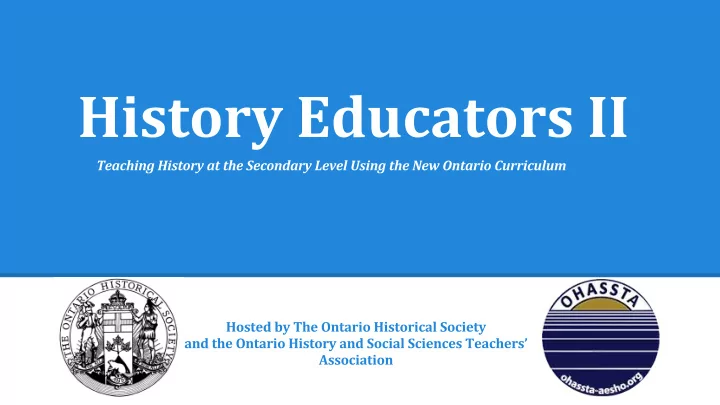

● ●
OHS Webinar Historical Thinking Sept. 30, 2014 Risa Gluskin Scott Pollock
Plan • Intro to historical thinking (20 minutes) • Examples of implementation of historical thinking (20 minutes) – CHC2D – CHC2P – CHC2D (ESL) • Questions and answers (20 minutes)
Introduction to Historical Thinking
The H. T. Concepts • Idea of “historical thinking” has a strong empirical foundation and has been a core aspect of curriculum in the UK, US, and Australia for some time. • Offers a strong rationale for the teaching of history (development of thinking) and allows teachers to avoid the content trap
Basic Principles of Historical Thinking • history ≠ the past • we do not need to turn students into historians, but rather, to help them understand how history is constructed • our interpretation of evidence , and what we leave out, changes the history we tell
The Historical Thinking Concepts in the Ontario Curriculum • Historical Significance • Cause and Consequence Overall Expectations • Continuity and Change • Historical Perspective-Taking • Use of Primary Source Evidence Inquiry • Ethical Dimensions of History Strand
inferences w o r l d v i e w t x e t n o c
The Historical Thinking Project. Historical Thinking Concepts. N.d. http: //historicalthinking.ca/historical-thinking-concepts (Sept. 13, 2014).
Teaching Concepts Explicitly • Historical thinking concepts are NOT in the background • They are NOT the secret language of history • They should be taught directly, often starting with personal examples
The Research • Can conceive of historical thinking as developing along a continuum • Research has identified many common student misconceptions. These are reflected in the guideposts • Can assist with planning and assessment
Guideposts / Criteria • Tools to help teachers enable students to do the critical thinking asked of them
Examples of Guideposts / Criteria • Significance – Are consequences deep? – For how many people? – Over how long a time? • Causes and Consequences – Intended and unintended consequences • Continuity and Change – Progress and decline – Turning points • Historical Perspectives – Avoid presentism (the imposition of today’s values and beliefs onto the past)
Historical Inquiry • The concepts work well in an inquiry- based classroom – Teacher avoids the need to teach everything about every topic – Puts exploration in the hands of the students
How and Why • More emphasis on how we teach rather than what we teach • Inquiry-driven search into why things happened the way they did • Let’s go through some of the details
Implementation
Introductory Activities • Teacher in a box – Highlights the interpretative nature of historical research – Introduces the idea of making inferences & the use of criteria Historical significance cards – Offers a preview of the course content – Opportunity to introduce the language (criteria) of historical significance – Assessment for learning (diagnostic) • Teachers use this information to set appropriate learning goals
CHC2D • Design down: Unit on the 1950s – Assessment of learning (summative) • D1 Social, Economic, and Political Context: describe some key social, economic, and political events, trends, and developments in Canada between 1945 and 1982, and assess their significance for different groups in Canada
1950s Oral History Project •D2. Communities, Conflict, and Cooperation: analyse some key experiences of and interactions between different communities in Canada, as well as interactions between Canada and the international community, from 1945 to 1982 and the changes that resulted from them
1950s Oral History Project • D3. Identity, Citizenship, and Heritage: analyse how significant events, individuals, and groups, including Aboriginal peoples, Québécois, and immigrants, contributed to the development of identity, citizenship, and heritage in Canada between 1945 and 1982 (FOCUS ON: Historical Significance; Cause and Consequence)
1950s Oral History Project • Interview people who were teenagers in the 1950s • Highlights that historians’ narratives are generalizations • Demonstrates the conflicted, contradictory nature of the 1950s • Great way to work with evidence
CHC2P • Historical Thinking & Applied Students – Inquiry is engaging – Challenge is tailoring activities appropriately (which is true of academic courses too!). • Collectors’ cards – Causes and consequences (intended and unintended) – Hands on Assignment courtesy of Jan Haskings-Winner, TDSB
• Curriculum Expectation: – C1. Social, Economic, and Political Context: describe some key social, economic, and political events, trends, and developments in Canada between 1929 and 1945, and explain how they affected the lives of people in Canada (FOCUS ON: Cause and Consequence) • Assessment of learning (summative)
ESL History • Continuity and Change in Canada’s Relationship with Quebec • Curriculum Expectation: – E2.4 describe some key developments and issues that have affected the relationship between Quebec and the federal government since 1982, and analyse them from various perspectives • Assessment as learning (formative) – Students monitor their own learning and use feedback to adjust, adapt or change what they understand
Continuity AND Change
Follow-up • When you ask “for whom” you are also bringing in historical perspectives • Students can use this scavenger hunt as a jumping off point – Deeper study can follow
Using the Achievement Chart Thinking Application - use of planning skills (e.g., finding - application of knowledge and skills in appropriate primary sources) familiar contexts - use of processing skills - transfer of knowledge and skills to new contexts (e.g., applying historical - use of critical/creative thinking thinking criteria) processes (e.g., inferring) - making connections within and between various contexts (e.g., past and present)
Questions
…
➢ ➢ ➢ ➢
Recommend
More recommend